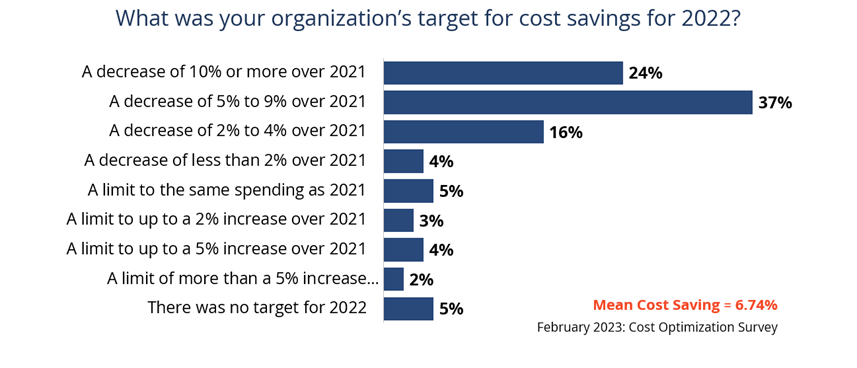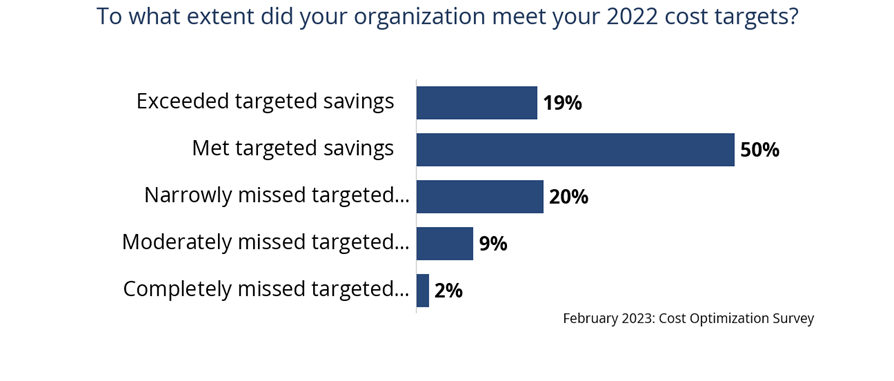Cost optimization is an essential process for organizations seeking to improve profitability and gain a competitive advantage. However, cost-saving initiatives can reflect a tangled mess of network cables, requiring careful planning and execution to effectively implement.
According to a recent ISG survey, 61% of organizations had a cost-savings target greater than 5% in 2022. Almost a third of those organizations missed their target. Respondents identified global economic conditions, staffing constraints and ineffective measurements of cost as the top three challenges in reducing cost. These challenges, along with various organizational complexities and constraints, make it difficult for enterprises to identify concrete cost optimization opportunities and improve cost performance.

Figure 1: Cost Targets Set in 2022

Figure 2: Cost Targets Met in 2022
5 Challenges to IT Cost Optimization
- Unclear alignment to business strategy: A key cost optimization challenge is the lack of clarity around the scope (including exclusions), objectives and organizational mandates of the cost transformation, and difficulty in aligning IT spend with business value and strategy. Initiatives often fail to fully achieve desired outcomes and end users can have differing perspectives on overall service quality.
- Challenges accessing accurate data: Lack of accurate data can hinder cost optimization efforts. Data challenges are commonly tied to poor data quality (e.g., outdated, conflicting sources, etc.), inaccessible/unavailable data sources, a limited level of detail and an absence of comparable market data.
- A siloed approach: When departments or teams operate in isolation, there is often duplication of effort and inefficient use of resources.
- Technology complexity: Changing market trends and increasingly complex solutions make it difficult to effectively implement IT initiatives. This can be exacerbated further by teams that lack required skillsets and inefficient contracts with technology partners.
- Resistance to change: One of the most significant challenges is resistance to change. Employees may be hesitant to embrace new technologies or processes, particularly if it means significant changes to their work routines. This resistance can lead to delays and increased costs.
5 Solutions to the Challenges of Cost Optimization
- Establish a clear strategy: The first step is to establish a clear strategy for the cost optimization effort. This strategy should clearly define the objectives, scope and timelines of the initiative and align back to the business strategy and requirements. Roles and responsibilities of key stakeholders should be defined, project effort budgeted and project status continually communicated. Conducting a business experience assessment can also help gauge key pain points and strengthen strategic relationships.
- Continuous data management: Organizations need to have access to accurate, current organizational data, as well as comparable market data, to make informed decisions about where cost savings can be made. An organizational benchmark provides a clear data structure aligned to representative market data to identify performance hot spots (20% savings on impactable areas, on average) and establishes a guide for ongoing data collection.
- Take a holistic approach: To achieve long-term success, organizations need to take a holistic approach to cost optimization. This means considering the impact of any changes on the entire organization and not just individual departments or functions. This approach can help avoid duplication of effort and ensure that cost savings are sustainable.
- Technology: Consider implementing cloud, automation and analytics solutions to streamline processes and reduce inefficiencies. Engage with strategic partners to address skillset gaps and implement proper governance to ensure costs and service delivery remain competitive.
- Organizational change management: Engaging employees is critical to the success of any cost optimization effort and will help drive productivity. Employees need to be informed about the rationale behind the changes and how they will benefit the organization. Communication is key, and employees should be given the opportunity to provide feedback and ask questions.
Cost optimization is a continuous process with data, related technologies and spend targets constantly changing. Success relies on connecting and organizing the various network cables, outlining a clear, holistic cost optimization strategy, establishing realistic targets supported by market data and promoting real-time collaboration between teams (e.g., procurement, engineering, finance, etc.). Remember to monitor progress regularly to ensure cost optimization efforts remain on track and identify any issues early on. Lastly, always remember to celebrate successes and reward employees for their contributions. This will ensure your organization sustains momentum, maintains engagement, and builds a culture of continuous improvement and innovation.
ISG helps enterprises drive sustainable cost savings with fact-based insights and innovative digital solutions. Contact us to find out how we can help.
